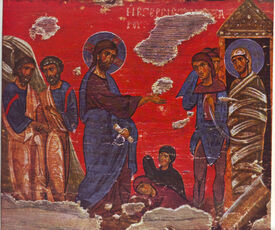This page is about the biblical figure. For the character, see Dr. Lazarus.

Resurrection of Lazarus. Private coll., Athens. 12-13 c. Воскрешение Лазаря
Lazarus of Bethany, also known as Saint Lazarus or Lazarus of the Four Days, is the subject of a prominent miracle attributed to Jesus in the Gospel of John, in which Jesus restores him to life four days after his death. The Eastern Orthodox and Roman Catholic traditions offer varying accounts of the later events of his life.
In the context of the Gospel of John, the narrative of the Raising of Lazarus forms "the climactic sign... Each of Jesus' seven signs illustrates some particular aspect of his divine authority, but this one exemplifies his power over the last and most irresistible enemy of humanity—death. For this reason it is given a prominent place in the gospel."[1]
A figure named "Lazarus" (Latinised from the Wikipedia:Aramaic: אלעזר, Elʿāzār, cf. Heb. Eleazar—"God is my help"[2]) is also mentioned in the Wikipedia:Gospel of Luke. The two Biblical characters named "Lazarus" have sometimes been conflated historically, but are generally understood to be two separate people.
The name "Lazarus" is frequently used in science and popular culture in reference to apparent restoration to life; for example, the scientific term "Lazarus taxon" denotes organisms that reappear in the fossil record after a period of apparent extinction. There are also numerous literary uses of the term.
References[]
- ↑ Tenney, Merrill C.. Kenneth L. Barker & John Kohlenberger III, ed. Zondervan NIV Bible Commentary. Grand Rapids, Michigan: Zondervan Publishing House.
- ↑ William Barclay, The Parables of Jesus, Westminster John Knox Press, 1999, ISBN 0-664-25828-X, pp. 92–98.
